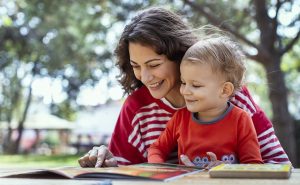Discover the benefits of wordless picture books
You know the importance of reading to your young child, but have you considered reading a wordless book to your child? A wordless book is a picture book tells the story solely through the pictures.
 When we read, we capture the meaning of the book via the words and pictures. If there are no words, then we rely on the pictures. A child does this naturally. He/she thoughtfully looks at a picture book. When you give a child a picture book with striking illustrations, you are inviting the child to "co-author" the story. That is pretty powerful.
When we read, we capture the meaning of the book via the words and pictures. If there are no words, then we rely on the pictures. A child does this naturally. He/she thoughtfully looks at a picture book. When you give a child a picture book with striking illustrations, you are inviting the child to "co-author" the story. That is pretty powerful.Reading a wordless book is a valuable introduction into the world of books and reading, and are a beneficial tool in developing literacy skills. Young children learn how a book works – front to back, top to bottom, and left to right. A wordless book engages young children in comprehension, critical thinking and storytelling. Wordless books also develop a greater understanding of story structure (characters, plot, etc.).
Research supports that when parents read wordless books with their young children it leads to more complex conversations and a richer vocabulary. Wordless books build the confidence of early readers and of reluctant readers. These books are accessible to children and families who speak any language. A wordless picture book encourages a child to use their imagination to retell the story again and again inspiring a love of books and art.
Tips for reading wordless books
Reading a wordless book may seem awkward or intimidating. Consider the opportunity it presents to invent a storyline, choose characters and create dialogue. Remember there is no wrong or right way to read a wordless book. Here are some tips for reading wordless books.
 Look at the cover for clues about the story.
Look at the cover for clues about the story.- Describe the details.
- Point to the pictures and connect your descriptive words with the picture.
- Give vivid explanations of what is happening in the picture.
- Wonder aloud.
- Ask your child questions. Such as: Where is he going? Why did she do that?
- Connect the events in the story with the next page.
- Add dramatic flair with interesting voices and sound effects.













